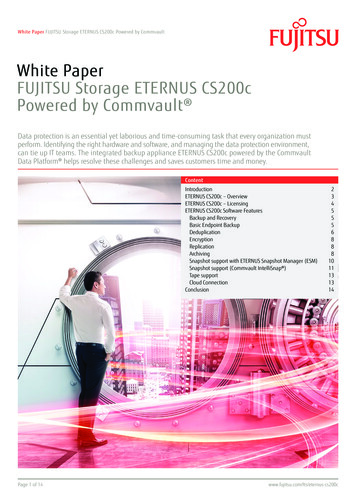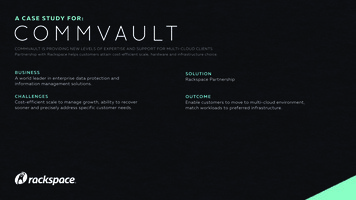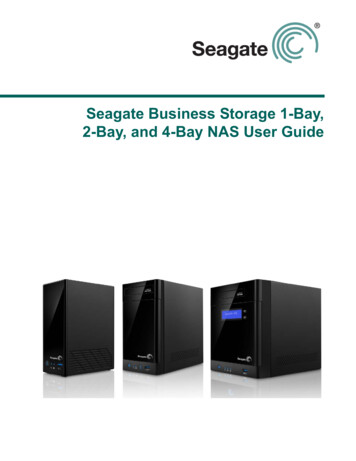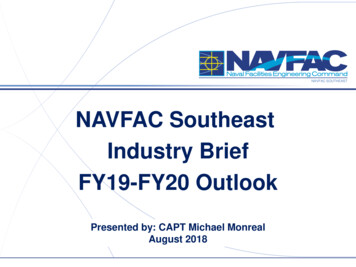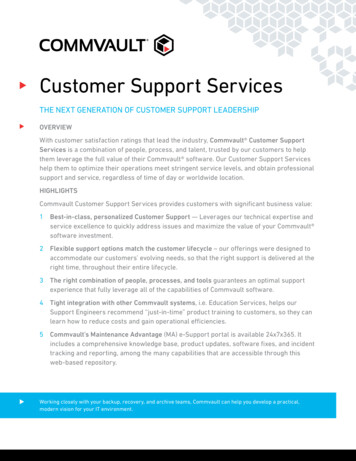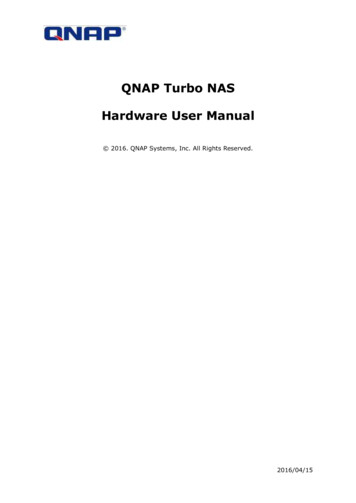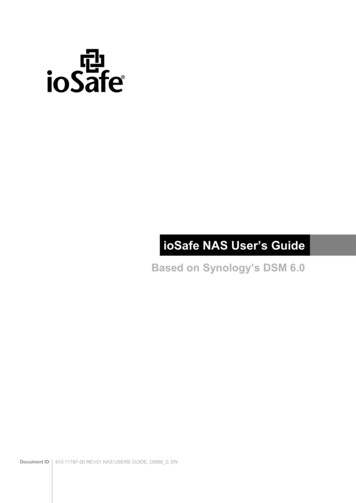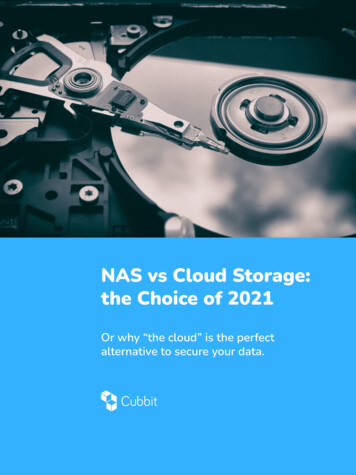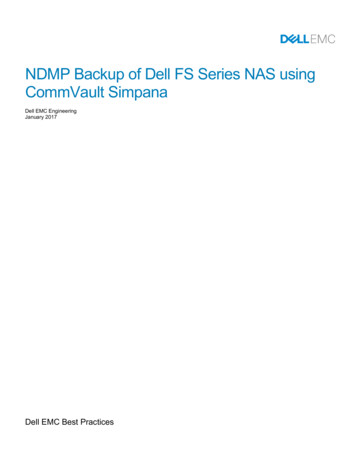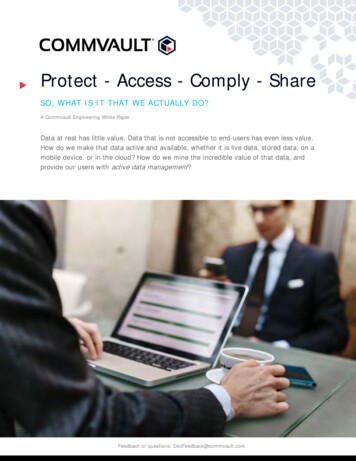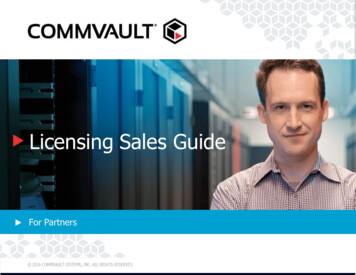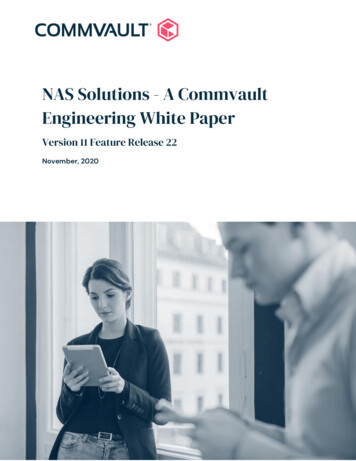
Transcription
NAS Solutions - A CommvaultEngineering White PaperVersion 11 Feature Release 22November, 2020
NAS Solutions - A Commvault Engineering White Paper - Feature Release 22ContentsNAS Solutions . 3Overview . 3Commvault NDMP support .4Implementation .4Configuration .4Advantages .5Commvault CIFS/NFS Support . 7Implementation . 7Configuration . 7Advantages .8Commvault NAS Snapshot Support .9Summary .9Copyright 2020 Commvault Systems, Inc. All rights reserved.2
NAS Solutions - A Commvault Engineering White Paper - Feature Release 22NAS SolutionsOverviewBackup and Archive support for Network Attached Storage (NAS) is still one of themost common customer requests to Commvault. As NAS data sets become larger, theneed for both backup and restore performance become more critical.Because NAS devices are dedicated file servers, they normally do not allow hosting ofapplications such as backup software. As such, most major NAS vendors support theuse of the Network Data Management Protocol (NDMP) for backup.NDMP is a common agent providing Application Programming Interfaces (APIs) whichcan be used to manage backup and restore of data on NAS file servers. NDMP APIsprovides use of direct-attached tape devices or NDMP-enabled backup softwarehosts with alternative storage support.Copyright 2020 Commvault Systems, Inc. All rights reserved.3
NAS Solutions - A Commvault Engineering White Paper - Feature Release 22All NAS vendors support the use of Common Internet File System (CIFS) or NetworkFile System (NFS) transport protocols. Using either CIFS or NFS protocols, NASvolumes can be shared and made accessible to backup software hosts for databackup and restore.Commvault offers both NDMP and Network Share (CIFS/NFS) scalable backupsolutions for NAS devices.Commvault NDMP supportBasic NDMP functionality provides for local (LAN-Free) backup and restore to anattached tape device. NDMP backups can also be written to a tape device attached toanother NDMP host. Commvault greatly expands on this basic functionality byenabling a wide range of features and options.ImplementationCommvault NDMP support is implemented through the use of a MediaAgent hostcontaining NDMP software with TCP/IP network connection to the NAS file server youwant to protect. Every MediaAgent component contains all necessary software.ConfigurationTo configure NDMP support, you just add a new NAS/Network Share Client to theCommCell environment. You need to provide a client name, host name (FQDN) andlogin credentials to access the NDMP software on the NAS file server, and the name ofa MediaAgent host with TCP/IP connectivity to the NAS file server. NAS clients have a"detect" property which allows both the MediaAgent connection and NDMPcredentials to be validated, and to automatically detect the file system content on theCopyright 2020 Commvault Systems, Inc. All rights reserved.4
NAS Solutions - A Commvault Engineering White Paper - Feature Release 22NAS file server. The default subclient will include all volumes in the backup. Userdefined subclients can be created to meet different data management requirementsand perform parallel backups and restores for better performance.AdvantagesSome advantages in using Commvault software’s NAS client with NDMP supportinclude:Copyright 2020 Commvault Systems, Inc. All rights reserved.5
NAS Solutions - A Commvault Engineering White Paper - Feature Release 22 Supports backup of mixed mode data and locked files. Security descriptors forboth Windows (ACL) and UNIX (Permissions) can be backed up and restored.Locked files are included in the backup providing crash-consistent backupsupport. With content indexing, end user specific access control to individual filescan be provided via Commvault software’s Web Console interface. Wild card content support for choosing volumes to backup. For example, youcan use "/bizdata*" to backup all bizdata department volumes across multiple NASvirtual servers, or you can use "/bizdata US svm /Oct*" to back-up all the Octobervolumes on the bizdata US svm virtual server. Less load on the file server and faster scan times for incremental backups. TheNAS file server recognizes and runs NDMP backup process at a lower priorityeffectively reducing impact to production users. NDMP backups are able to use thejournaled file system on the NAS file server for faster identification of changed dataneeding to be backed up. Cross platform restore. NDMP backups can be restored to Windows or UNIX filesystem platforms. Consult Commvault documentation for supported NAS vendors. Eliminates need for CIFS / NFS shares to be created on all the volumes with userconfigured access to the data. Using a NAS client’s NDMP agent with its singleuser credentials saves both administrative management time in creating andmaintaining multiple network shares, and provides an increased level of security byreducing the need for multiple CIFS/NFS login credentials. Content paths/volumes can be backed up in parallel for highest data rates.Data transportation can be "multi-streamed" across a number of data paths and/orMediaAgents. A single subclient can have multiple streams by setting the numberof data readers. A proxy client group of MediaAgents can be assigned to asubclient to allow load balancing and multi-node backups. Support for NetApp and Dell Dell EMC Isilon’s NDMP restart extension. Allowsresumption of interrupted NDMP backups from point of interruption. Support for use of the Cluster Aware Backup NDMP extension which minimizesdata passed between physical nodes in the NetApp cluster. In addition to thisextension, Commvault’s cluster support can work with Individual virtual server(vserver) clients which do not need to have NDMP credentials. When a vserver’sNDMP client credentials are not set, Commvault logs into the cluster and runs theNDMP backups or snap operations from the cluster. This configuration allowscustomer to setup vserver clients and set user permissions per vserver client whilestill allowing the backups to be run through the cluster interface. With a NetAppMetro Cluster configuration, a cluster may fail over to its partner. CommvaultCopyright 2020 Commvault Systems, Inc. All rights reserved.6
NAS Solutions - A Commvault Engineering White Paper - Feature Release 22detects when the failover has occurred and continuing data protectionuninterrupted. Support for Dell Dell EMC Isilon multi-stream NDMP. On the NAS subclient youcan specify multiple streams of data to back up concurrently. Multi-Tenant/Managed Service Provider support. In a multi-tenant environment,each tenant can back up to through one or more local proxy MediaAgent hosts fordeduplication and encryption before being sent to the service provider’sMediaAgents. This provides significantly more efficient use of bandwidth and ahigher degree of security. High deduplication ratio. For most vendors Commvault can achieve a highdeduplication rate. Encryption, compression, data verification, content indexing, analytics,reporting, and auxiliary copy support. Backing up data via a MediaAgent hostallows Commvault to use numerous data management features to enhancestorage, security, management, and data access options.Commvault CIFS/NFS SupportAll NAS file servers support backup/restore via CIFS/NFS transport protocols. It’ssimply backing up data from a network share.ImplementationCommvault CIFS/NFS support is implemented through the use of a Data Access nodewith TCP/IP network connection to the NAS file server you want to protect. A DataAccess node is a Commvault File System Agent host.ConfigurationTo configure CIFS/NFS support, you just add a new NAS/Network Share client to theCommCell environment. You provide a client name and select which transportprotocol - Windows(CIFS) or Unix(NFS) you will be using. You can select both. Apseudo client with the selected file system agent will be created. Data Access nodesare configurable at the agent or subclient level with subclient level having overridepriority. For CIFS shares you would select clients with the Windows File System Agentinstalled. For NFS shares you would select clients with a Unix-like File System Agentinstalled. The ability to select more than one Data Access node provides for bothscalability (multiple paths) and redundancy (failover/alternate paths).Copyright 2020 Commvault Systems, Inc. All rights reserved.7
NAS Solutions - A Commvault Engineering White Paper - Feature Release 22AdvantagesSome advantages in using Commvault software’s NAS client with CIFS/NFS supportinclude: End user security support using backup of Windows (ACL) or UNIX(Permissions). Appropriate end user permissions are necessary when browsing orrestoring individual data files via Commvault’s Web Console interface. Multi-node/Multi-stream scan and backup. Both the scan and backups phasescan use multiple data access nodes/streams. This functionality allows loadbalancing, alternate data paths, and greatly increases the speed of the backups. Deduplication, Encryption, compression, data verification, content indexing,analytics, reporting, and auxiliary copy support. Backing up data via data accessCopyright 2020 Commvault Systems, Inc. All rights reserved.8
NAS Solutions - A Commvault Engineering White Paper - Feature Release 22nodes allows Commvault to use numerous data management features to enhancestorage, security, management, and data access options. Support for Incremental forever backups. After an initial full backup, you can runjust incremental backups to capture only changed data. Synthetic full backups arealso supported. Support for restartable backups for either CIFS or NFS data. Allows resumptionof interrupted backups from point of interruption.Commvault NAS Snapshot SupportSnapshot (Commvault IntelliSnap ) is supported for NAS clients using either NDMP orCIFS/NFS backup agents. Snapshots primarily provide for fast, point-in-time copiesand restore. Multiple snapshot copies can be saved with minimal block base datausage.IntelliSnap is supported for volumes on NetApp storage servers, Dell EMC Celerra ,Isilon , Unity VNX , or VNXe file servers, and Huawei storage systems. NetApp alsoallows single file snap restore (SFSR) for fast block level restore for files.Snapshots provide storage/backup administrators with numerous capabilities andoptions such as: Mounting a file server volume copy for test environment Defer or skip catalog from Snap copy to minimize impact on production users. Backup copy from Snap copy to minimize impact on production users. Live browse of Snap copy – including alphabetic listing for fast restores. Faster block level backups and restores.NetApp storage servers make extensive use of snapshots for vault and mirror copyorchestration and Isilon SyncIQ for data replication. Commvault IntelliSnap softwarecan help facilitate and manage the snapshot/replication process. Consult Commvaultdocumentation for specific vendor support.SummarySome other vendors may say NDMP is a legacy software. And they are right – If all youare evaluating is the protocol’s basic functionality. But Commvault software enhancesNDMP and adds a wealth of features. Commvault software is a force multiplier forCopyright 2020 Commvault Systems, Inc. All rights reserved.9
NAS Solutions - A Commvault Engineering White Paper - Feature Release 22NDMP. Commvault has numerous clients with NAS storage servers where Commvault’sNDMP backups are the best solution.For CIFS/NFS – the universal backup method for all NAS storage servers – Commvaultbrings its entire range of data management features to bear and provides a highlyscalable and high performance solution.Commvault’s IntelliSnap is a force multiplier to both NDMP and CIFS/NFS backups andprovides numerous benefits to administrators, specifically when multiple copies,replication, and quick restores are needed. Check out Commvault documentation formore details.Copyright 2020 Commvault Systems, Inc. All rights reserved.10
NAS Solutions - A Commvault Engineering White Paper - Feature Release 22Copyright 2020 Commvault Systems, Inc. All rights reserved.11
1999-2020 Commvault Systems, Inc. All rights reserved. Commvault, Commvault and logo, the "C hexagon”logo, Commvault Systems, Commvault HyperScale, ScaleProtect, Commvault OnePass, Unified DataManagement, Quick Recovery, QR, CommNet, GridStor, Vault Tracker, InnerVault, Quick Snap, QSnap, IntelliSnap,Recovery Director, CommServe, CommCell, APSS, Commvault Edge, Commvault GO, Commvault Advantage,Commvault Complete, Commvault Activate, Commvault Orchestrate, Commvault Command Center, Hedvig,Universal Data Plane, the “Cube” logo, Metallic, the “M Wave” logo, and CommValue are trademarks or registeredtrademarks of Commvault Systems, Inc. All other third party brands, products, service names, trademarks, orregistered service marks are the property of and used to identify the products or services of their respectiveowners. All specification are subject to change without notice.The development release and timing of future product releases remains at Commvault’s sole discretion.Commvault is providing the following information in accordance with Commvault's standard productcommunication policies. Any resulting features, functionality, and enhancements or timing of release of suchfeatures, functionality, and enhancements are at the sole discretion of Commvault and may be modified withoutnotice. All product roadmap or other similar information does not represent a commitment to deliver anymaterial, code, or functionality, and should not be relied upon in making a purchasing decision.Visit the Commvault Documentation website for complete documentation of Commvault products.COMMVAULT.COM 888.746.3849 GET-INFO@COMMVAULT.COM
use of the Network Data Management Protocol (NDMP) for backup. NDMP is a common agent providing Application Programming Interfaces (APIs) which can be used to manage backup and restore of data on NAS file servers. NDMP APIs provides use of direct-attached tape devices or NDMP-enabled backup software hosts with alternative storage support.
